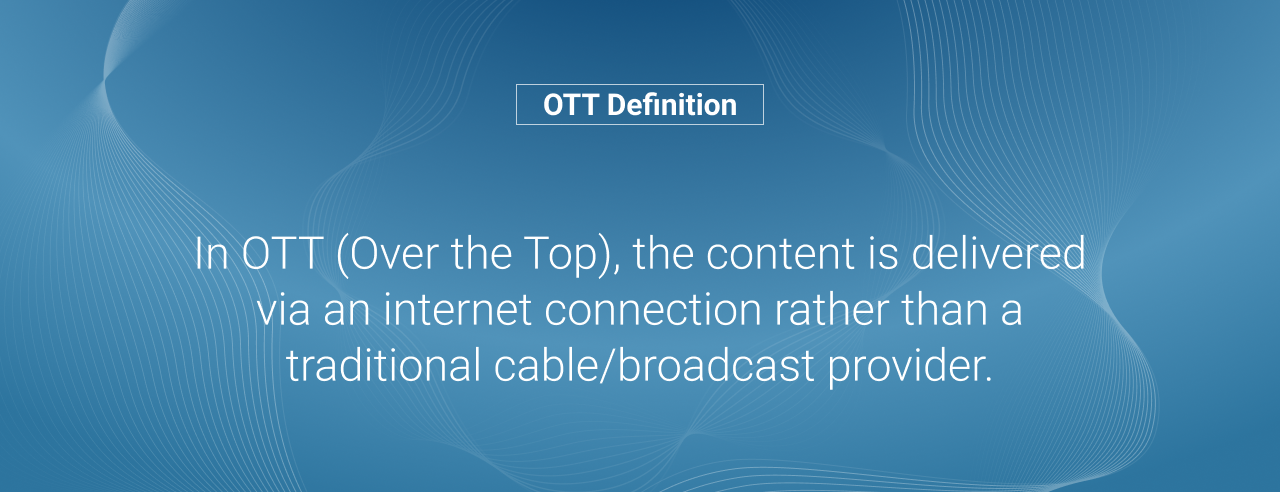Do you remember the days when television media and radio used to rule? The only way to watch your favorite show was towatch it when the distributors broadcasted it. But now, OTT is the new living revolution for the entertainment industry.As a result, it has become easy for us to watch any show at anytime, anywhere and at a minimal cost compared to thetraditional way. With the entertainment industry, OTT has bought changes and is still bringing them to other sectors as well. A simple example is banking services. Traditionally you physically have to visit the bank for anything you need. Now, with OTTbanking apps, you can avail most of the banks’ services from the comfort of your home. So, let’s look at how OTT ischanging the other industries and the future.
Everything you should know about OTT
OTT stands for “over-the-top” and represents the future of entertainment – one that is already unfolding. An industrial revolution is not always easily acceptable. However, in the case of OTT, users become comfortable with it easily.
In 2019, Netflix spent $15.3 billion on content, and that number is expected to grow to $26 billion by 2028. These figures clearly state that OTT is one of the fastest growing media and entertainment segments. Hence, it is important to understand this part of the media and know the fundamentals of it.
What is OTT?

In ‘Over the Top,’ the content is delivered via an internet connection rather than a traditional cable/broadcast provider. Initially, it is named in reference to devices that go “over” a cable box to give the user access to TV content. This unique ability to provide users with video-on-demand enables the industry to proliferate.
Now, the OTT isn’t limited to video streaming. It has been applied to many other products and services that stream content to users using the internet to replace pre-existing infrastructure. When looking at OTT from a broader perspective, it can be fit into three buckets:
-
OTT Services
Many offline services are going over the top and breaking the need to be physically or traditionally managed. For example, hailing a taxi before was a physical task. Now, with taxi service and ride-sharing apps, the process of physically fetching a taxi is disrupted, and this has proved to be a revolution for the taxi industry. Other OTT service examples are online payment methods, eCommerce, stock trading, and more.
-
Content and Message Delivery OTT Solutions
The OTT has many advantages. One of them is not having to pay cable bills because of the easily-accessible streaming services. The best examples of this are Netflix, YouTube, Hulu, and Mobi TV. Though OTT and video-on-demand (VOD) are generally braided together, they are not the same. But, more on that later. Internet services are also being utilized to connect phone calls and send messages. Traditionally, text messages are sent using cellular services, but today many OTT apps like WhatsApp, Skype, iMessage, and others allow users to communicate via the internet.
-
OTT Devices
OTT devices allow us to use the latest technology for our benefit. For example, with the help of Chromecast, Amazon Fire Stick, Mi TV Stick, you can watch your favorite streaming content on the TV. IoT technology is also helping OTT in enhancing the experience of the user. With voice commands and search, users can use OTT devices to their best. The best example of this is Amazon’s Alexa devices. They enable you to set the alarm, listen to any show, ask for weather and news, command to turn on/off smart lights, and more. All of these can be done with the voice command.
Content Types for OTT Solutions

Initially, OTT content was assumed to be video-only. But OTT Solutions contains a broad range of content:
-
Video
Video streaming is the most popular and widely recognized form of OTT media services. Subscription platforms like Netflix, paid storefronts like iTunes, and ad-based platforms like YouTube are popular platforms for this.
-
Audio
Along with video, audio streaming is possible through OTT services. Popular examples include internet radio stations and podcasts. There are currently over two million active podcasts and more than 48 million podcast episodes, as of 2021.
-
Messaging
OTT provides instant messaging services that connect users directly through an internet connection, circumventing mobile SMS networks. There are many platforms that offer this service such as Facebook, Google, Skype, and more. Moreover, most are capable of integrating with smartphone text messaging features.
-
VOIP
It is the abbreviation for Voice Over Internet Protocol. In this, a user can call using the internet via multiple voice calling platforms like Skype. To enhance certain features of network calling, these services can easily integrate with them.
OTT Vs VOD
OTT is often considered a synonym for VOD. However, in reality, they are different from each other.
To unlock the service of VOD, it requires you to pay for a cable package subscription. This is where the line between VOD and OTT is drawn. For example, HBO GO is where you can watch online shows. However, in order to watch it, you must authenticate your TV provider subscription.
OTT is opposed to this model of adding an extra payment layer to watch content. Instead, it captures media content delivered over the internet without any traditional subscription. Netflix, Disney+, Amazon Prime, and Mubi fall in the category of OTT broadcasting platforms, allowing the user to pay for what they want to watch.
How is OTT delivered?

The main reason OTT became popular is its accessibility. To stream OTT, all you require is high speed internet and a connected device that supports OTT apps or browsers.
Mobile Devices: All smartphones and tablets are enabled to download OTT apps. This makes streaming on-the-go easy for all.
Personal Computers: Along with apps, it is possible for you to access OTT content from desktop-based apps or web browsers.
Smart TVs: Televisions are now made to include OTT apps as one of their prime features. The most common examples are Apple TV, Firestick, and more.
Own a Video Streaming OTT Vs Own a YouTube
Owning an OTT channel is far different and better than owning a YouTube channel. There are many aspects to it. Let’s have a look at them:
| OTT | YouTube | |
|---|---|---|
| Ownership | Complete Ownership | Shared Channel |
| Engagement | User stays with you till you provide quality content | There’s always a threat of getting your viewers highjacked by other channels |
| Monetization | Possible even with minimum subscribers | Requires to fulfil a criterion and demands lots of efforts in earning money and gaining subscribers |
| Ads | Customized Ads according to our will | Configured by the platform |
| Revenue | Our revenue belongs to us | A little percentage of total revenue is given to us |
| Gamification for Users | Possible | Not Possible |
| Content Restriction | None | Yes |
| Rules and Regulations | You own rules and regulations here | If YouTube policy changes, there is a threat to your channel and revenue |
Is OTT replacing traditional cable media?
The biggest question after knowing about OTT is if it is outperforming the traditional form of media. Well, it’s no surprise that streaming videos are taking over television. As of 2021, Netflix has 213.6 million paying subscribers worldwide and growing.
OTT offers high-value content at a low price. It is cost-efficient than cable TV packages. Along with this, OTT platforms stream classic movies and TV shows with their originally produced content. They make this content exclusively available on the platform with paid subscription along with having licenses to add previously televised content.
If you have an OTT subscription, you can access it from anywhere and on any device, be it your smartphone, smart TV, gaming console, and/or tablet. The user experience is consistent through all the devices. Moreover, the reason OTT is popular and is preferred by most users is because of the convenience to watch anything at any time. You don’t have to wait to watch any show and are free to switch between shows, if you don’t like one.
Because of all the reasons mentioned above, OTT is getting a lot of traction, even being relatively new. Not only video streaming OTT, but other forms of it too. If we take the example of taxi service, it is clear from the facts that it is one of the fastest-growing industries. Other OTT apps like WhatsApp have also changed the world. It has added 1 billion new users over the last four years (2016-2020).
To conclude, OTT beating all traditional means is not possible in today’s time. Because HBO’s move of going online even with the subscription of cable TV suggests that traditional media is not lagging. So, the scenario of which media will rule in the future is unpredictable as of now.
To Sum It Up
One of the most fundamental advances to the distribution landscape is clearly the concept of OTT. And it is here to stay because of the freedom of choice and satisfying experience it gives to the consumers. OTT is a growing business and if you are thinking of being a part of it, then think no more. Jump right into it with the right guidance and expertise, provided at an affordable price at AppManufact.
Join the Revolution of OTT with AppManufact
We, at AppManufact take you forward with the revolution of OTT. Build your own OTT app with us and get your users a satisfying experience and enjoyable space. Do it to let them watch what they like or provide the best alternative for a traditional service. Our team of industry experts guide you with the appropriate solutions and help you expand your reach with the right strategies. Contact them today and get your journey started!
FAQs
What is the OTT Platform?
The OTT platform refers to any streaming service that delivers content over the internet.
What is the example of OTT?
Netflix, Amazon Video, HBO Now, Mobi, Hulu, and more are the existing OTT video-streaming platforms.
What is the full form of OTT?
OTT is the abbreviation for ‘Over the Top’ which means providing content over the internet that suit the requirements of the individual consumer.
How does the OTT platform earn money?
OTT platforms earn money through the Ad revenue model, where they charge brands for displaying/streaming their ads on the platform.



